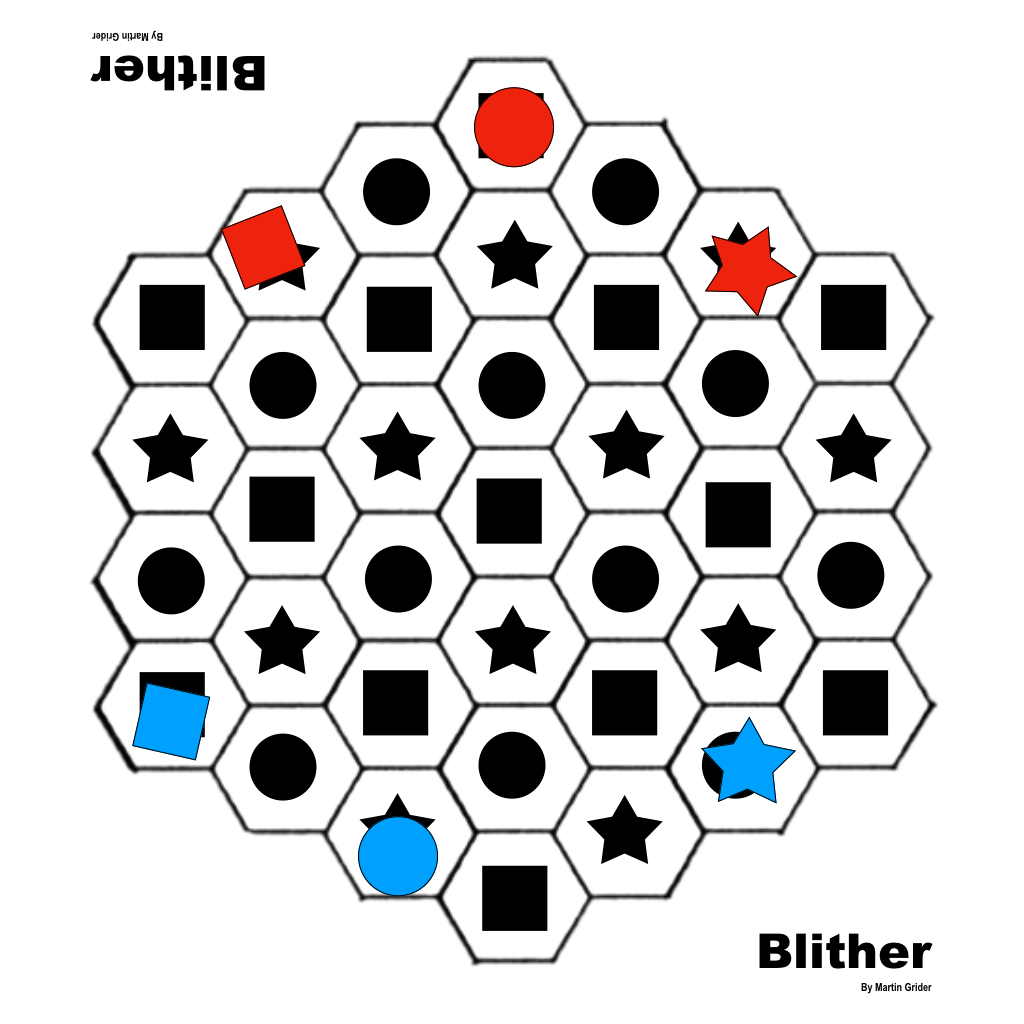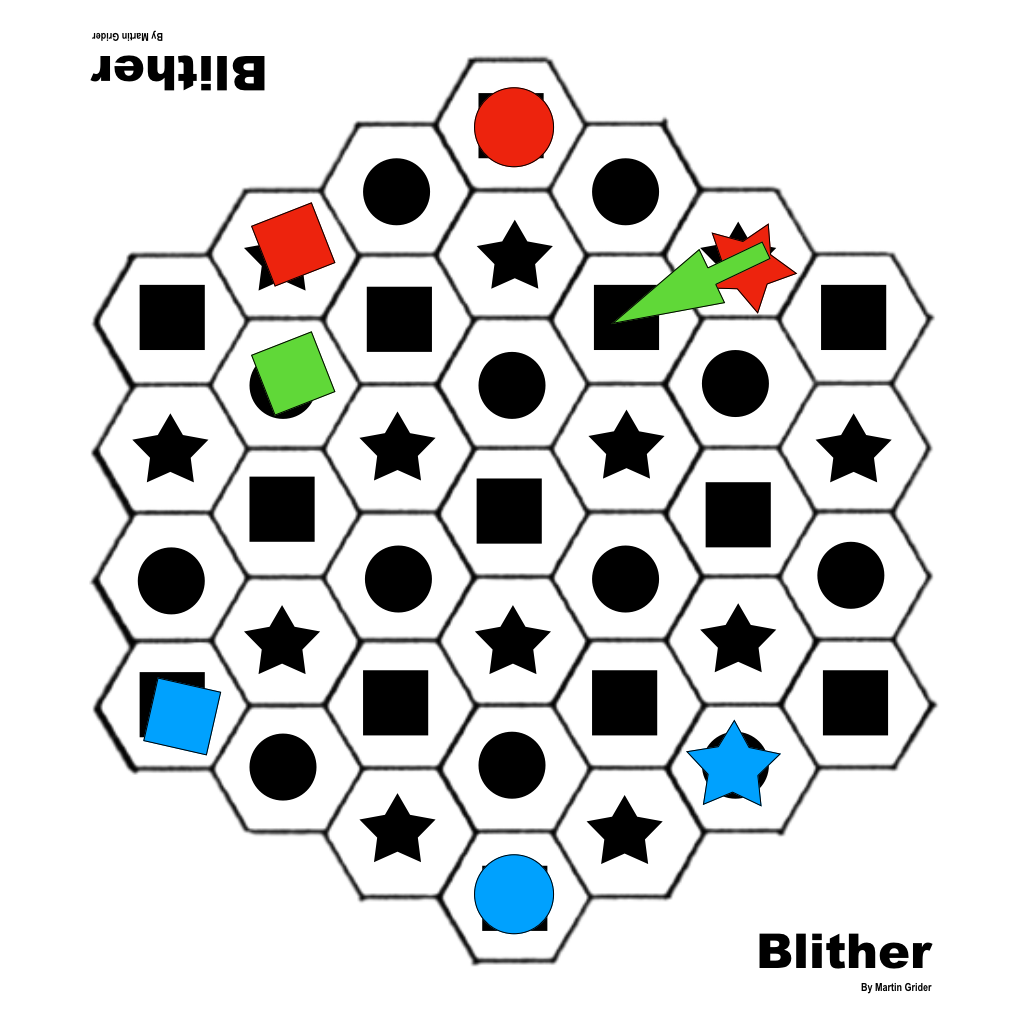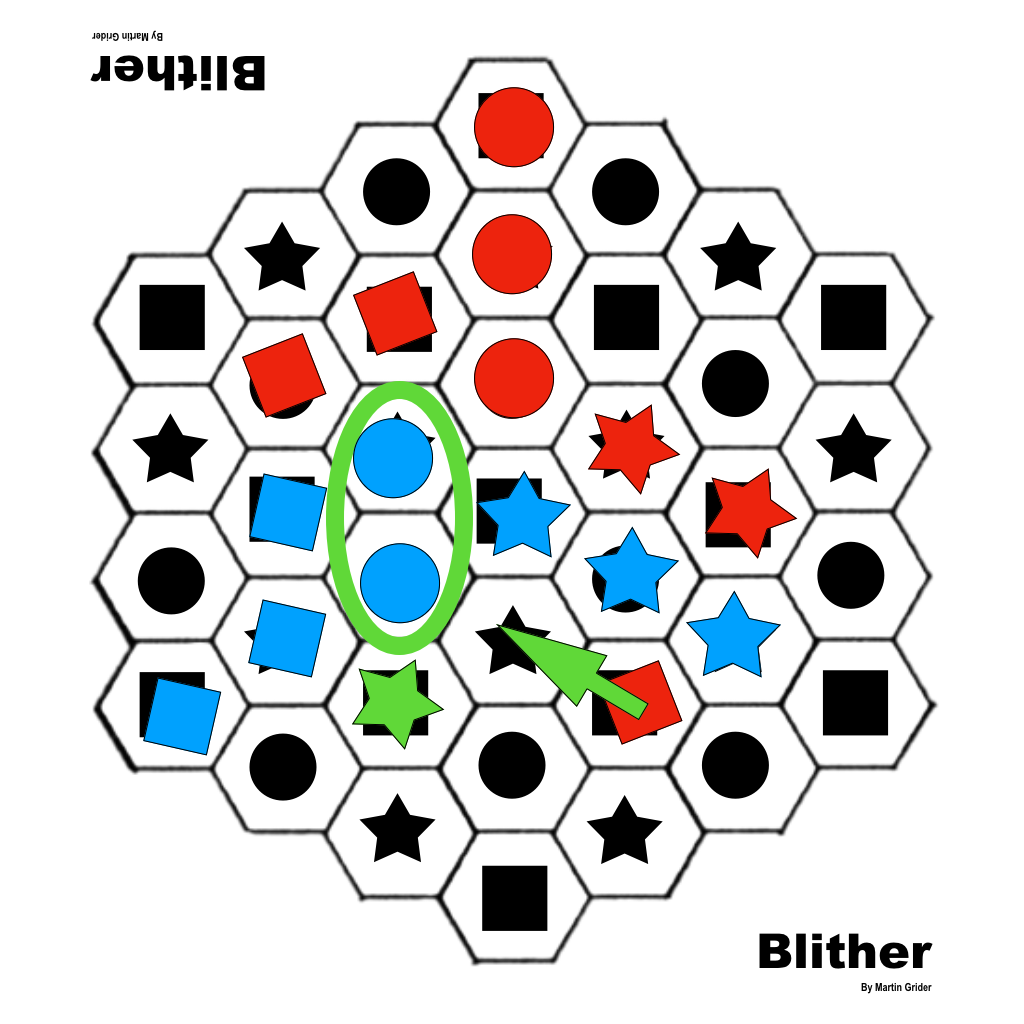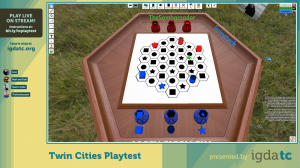
Blither is a simple capture and territory game for two players.
Setup
Each player takes all the pieces of one color.
Players place one piece of each shape along the two sides of the gameboard closest to themselves, with the only restriction that no piece should start next to any other pieces.
Choose a starting player.
Goal
Players are trying to capture groups of their opponent’s pieces. The goal is to be the first to have captured at least one of each of their opponent’s three piece types.
Gameplay
On a turn, the player moves one of their pieces already on the gameboard one space to an adjacent unoccupied space. After they move, the player must add a piece from their supply matching the type of the space they moved onto, placing it onto any unoccupied space on the gameboard.
Finally, all of their opponent’s groups are evaluated (each type forms a different group), and any groups that have no liberties (empty spaces around them) are removed from the board. The capturing player keeps one of each type of piece that was removed, displaying it clearly on their side of the board. If a player has one of each of the three types of their opponent’s pieces, the player immediately wins the game.
Example Move
In this first move of the game, the Red player moves their Star piece onto a Square space on the board. They then choose any space on the board to add another Square piece.

Example Capture
In this example, the Red player is moving their Square piece onto another star space on the board (next to the Blue player’s group of Circle pieces). They will then add another Star piece on the space indicated, after which the Blue player’s group of two Circle pieces will have no empty spaces around it, and both pieces in the Blue Circle group will be removed. The red player will keep one of the Blue Circle pieces and display it on their side of the board.

Extra Stuff
Inspiration
Blither was inspired by the Abstract Games Magazine Unusual Board Spaces Game Design Competition, specifically, by the game Hox, which is described as an example for the competition. It was also inspired by Blooms, by Nick Bentley, and Slither, by Corey Clark. Mechanics from both games have been adapted here, and the name Blither is a portmanteau of the two. I am especially happy with this design because, at least to me, Blither also feels like both of those games.
Online Play
You can play Blither on Tabletop Simulator here: https://steamcommunity.com/sharedfiles/filedetails/?id=2492141466 This is actually my first Tabletop Simulator mod, and I’m pretty happy with how it turned out. It doesn’t do anything especially fancy though.
Watch it played
You can watch a game of Blither on YouTube from when it was played as part of the Twin Cities Playtest event in May 2021. I do also introduce the game and the rules before they play.

About the Components
The number of pieces of each type is not meant to be limited. But in practice, I have not seen a game where any player used more than 14 of one piece type. (That said, I haven’t seen that many games yet.) It would of course be theoretically possible to use many more than that. I have played a game or two with a limited number of pieces (9 of each type), and that seemed to go okay as well.
I have spent some time working on 3D printed components for a physical version of the game, but I haven’t finished printing them out yet.
Why is it interesting
If you’ve played Blooms and/or Slither, you already know why those games are interesting. Briefly, here are my takes:
Blooms feels like an expanded version of Go, both because it’s on a hexagonal board, but also because there are four colors in the game. (Each player owns two of them.) The choice of which color to place is an expansion of the decision space in a similar way to how there are additional liberties for each board space. (There are 4 in Go because it’s a square grid versus 6 in Blooms because it’s played hexagons.) I am by no means an expert Blooms player, but my impression is that you must analyze each color’s liberties alone as well as in tandem with your other color, which is more than just double the thinking, but fortunately, the board is much smaller overall. Abstract Strategy Games magazine had a feature article on Blooms (and hexagonal Go in general) in their 20th Issue, and I do recommend it.
Slither is a very interesting version of a connection game because you get to move your pieces. As a connection game, the goal is to form a connected group of stones from one side of the board to the other. But because you get to move your pieces, (and the name is particularly apt here), those lines of stones end up slithering around the board over the course of the game. In Slither, you move a stone, and then place a stone, (although unlike Blither, the move is optional). This is, of course, an expansion of the decision space of a traditional single-placement connection game (Hex is probably the most well-known) because the movement opens up many more possibilities for connection in a single turn. David Ploog has written a nice article about Slither that introduces the rules and goes into more depth on why the game is interesting.
Blither combines some of the mechanics of both Blooms and Slither. But I’d argue it does so in such a way that expands the decision space in a similar way to how both of those games expand the decision spaces in respect to their direct predecessors. In terms of how it feels to me to play Blither, I’d argue that Blither is to Blooms what Slither is to Hex.
Blooms and Go and Slither and Hex are all in a family of abstract strategy games that connoisseurs of such games refer to as combinatorial. Combinatorial games are games for 2-players with no reliance on luck or hidden information. Some definitions say the game also has to be finite (meaning it can’t end in a draw). People who value combinatorial games also tend to value the following game attributes: elegance and simplicity. I could definitely write an entire article about just the previous sentence, but I won’t go into detail about what that means just now. Blither is combinatorial, but it might be that the number of components (hopefully not the number and complexity of the rules) is beginning to impinge on its claim to elegance and simplicity.
Right now, I feel like Blither is one of the better games I’ve designed. I hope you’ll give it a try.
UPDATE (2021-12-07)
I updated the rules explanation in this post to my current favorite version (v1.1). Also added a couple of visual examples.
